

Unimaginable View of Milky Way From Year of Observations by NASA TESS – 29 Exoplanets Discovered. New Research Suggests that the Universe is a Sphere and Not Flat After All. The universe is a seemingly endless sea filled with stars, galaxies, and nebulae.
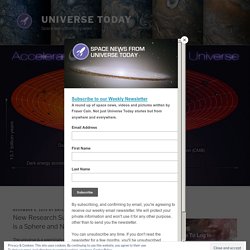
In it, we see patterns and constellations that have inspired stories throughout history. But there is one cosmic pattern we still don’t understand. Interstellar space even weirder than expected, NASA's Voyager 2 reveals. In the blackness of space billions of miles from home, NASA’s Voyager 2 marked a milestone of exploration, becoming just the second spacecraft ever to enter interstellar space in November 2018.

Now, a day before the anniversary of that celestial exit, scientists have revealed what Voyager 2 saw as it crossed the threshold—and it’s giving humans new insight into some of the big mysteries of our solar system. The findings, spread across five studies published today in Nature Astronomy, mark the first time that a spacecraft has directly sampled the electrically charged hazes, or plasmas, that fill both interstellar space and the solar system’s farthest outskirts. -tests-rocket-next-starlink-launch. CAPE CANAVERAL, Fla. — SpaceX has fired up the rocket booster that will ferry the company's next batch of Starlink satellites into space.

The company conducted a static-fire test on Tuesday (Nov. 5) of a Falcon 9 rocket at Space Launch Complex 40 at Cape Canaveral Air Force Station in Florida, the company said on Twitter. That rocket is expected to send 60 Starlink internet satellites into space no earlier than Monday (Nov. 11), ending a nearly three-month launch hiatus for the company. Giant planet HR 5183b would look 15 times brighter than Venus. Artist’s concept of Venus – brightest planet visible from Earth and a dazzling light low in the west after sunset now – in contrast to the brightness of the giant planet in the distant star system HR 5183.
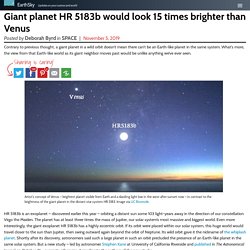
Image via UC Riverside. HR 5183b is an exoplanet – discovered earlier this year – orbiting a distant sun some 103 light-years away in the direction of our constellation Virgo the Maiden. Holographic Duality Yields Breakthrough in Black Hole Physics. A group of Skoltech researchers led by Professor Anatoly Dymarsky studied the emergence of generalized thermal ensembles in quantum systems with additional symmetries.
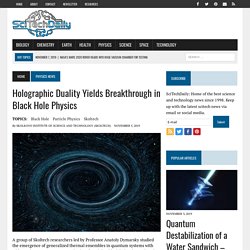
As a result, they found that black holes thermalize the same way ordinary matter does. The results of their study were published in Physical Review Letters. The physics of black holes remains an elusive chapter of modern physics. It is the sharpest point of tension between quantum mechanics and the theory of general relativity. According to quantum mechanics, black holes should behave like other ordinary quantum systems. There's Something Strange Going On Inside Neptune. When Voyager 2 reached Neptune in 1989, just 12 years after setting off on its historic journey through the solar system, it discovered six new moons, took the first images of the planet's rings and noted a particularly violent storm.
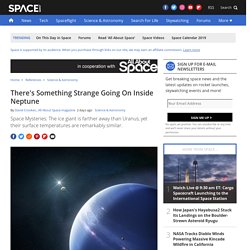
The storm was something of a surprise. Breakthrough Listen and TESS team up for SETI. In recent decades, missions to planets and moons in our solar system have been alert for signs of microbial life.

Astronomers have found thousands of exoplanets, or worlds orbiting distant suns. Small asteroid paid a heavy price for almost striking Earth Thursday. Artist’s concept of an asteroid approaching Earth.
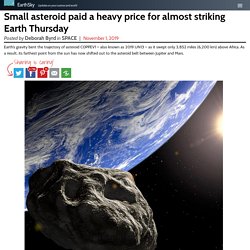
UPDATE: The Center for Near-Earth Object Studies (CNEOS) has now added a size estimate for this object: 1 to 2.2 meters. If it had come closer, and entered our atmosphere, it would likely have vaporized due to friction with the air. I happened to catch this post on Twitter Friday morning, from Tony Dunn (@tony873004), an amateur astronomer and physics teacher who knows how to create simulations of asteroids’ orbits. Tony tweeted: He’s talking about near-Earth asteroid C0PPEV1 – now renamed 2019 UN 13 – spotted in the early morning hours of October 31, 2019 by the Catalina Sky Survey in Arizona, and by other observatories soon afterwards. According to data from these early observations, the asteroid came closer to the surface of our planet (without actually colliding with our atmosphere) than any other close approach in NASA’s database of known near-Earth objects.
Hubble Space Telescope Spots a Galaxy – And It’s Not Alone. Galaxies may seem lonely, floating alone in the vast, inky blackness of the sparsely populated cosmos — but looks can be deceiving.

This image of NGC 1706, taken by the NASA/ESA Hubble Space Telescope, is a good example of this. NGC 1706 is a spiral galaxy, about 230 million light-years away, in the constellation of Dorado (the Swordfish). NGC 1706 is known to belong to something known as a galaxy group, which is just as the name suggests — a group of up to 50 galaxies which are gravitationally bound and hence relatively close to each other. Around half of the galaxies we know of in the universe belong to some kind of group, making them incredibly common cosmic structures.
Our home galaxy, the Milky Way, belongs to the Local Group, which also contains the Andromeda galaxy, the Large and Small Magellanic clouds, and the Triangulum galaxy. Image: ESA/Hubble & NASA, A. New study says cosmic acceleration and dark energy don't exist. Paper by Oxford University physicist Subir Sarkar and his colleagues challenges how conclusions about cosmic acceleration and dark energy were reached.Physicists who proved cosmic acceleration shared a Nobel Prize.Sarkar used statistical analysis to question key data, but his methodology also has detractors.

Is our Universe's expansion speeding up? The 2011 Nobel Prize went to three scientists for proving just that. Miniature Black Hole Surprises Astronomers: It Shouldn’t Exist. Generally speaking, black holes are the corpse of a dead star. But not all stars become black holes at the end of their life – for instance, our familiar Sun is small enough to avoid that fate. Until recently, black holes were thought to be formed only by super-massive stars, and the smallest black hole known to scientists was about five times the mass of the Sun.
However, a recent scientific paper has announced the discovery of a black hole much smaller than that. There's Something Strange Going On Inside Neptune. Mars Rover Curiosity Snaps Beautiful Selfie After Rare Chemistry Experiment. (Image credit: NASA/JPL-Caltech/MSSS) NASA's Curiosity Mars rover performed some rare science work recently, then took a bit of a break to take in the austere beauty of its surroundings. On Sept. 24, Curiosity conducted a "wet chemistry" experiment for just the second time ever during its seven years on the Red Planet, dropping a drilled sample into a special solvent that could help the rover identify carbon-containing organic molecules. The mission team took this step because Curiosity is now exploring an area, dubbed "Glen Etive," that's rich in clay minerals.
Astronomers Just Found the First Evidence That 'Mini Black Holes' Exist. An entirely new class of black holes may be lurking in the universe, and these may be far tinier than what scientists have found before, according to new findings. Black holes are massive celestial objects that gobble up everything that comes too close; not even light can escape a black hole's intense gravitational grasp.
The search for black holes, small and large — such as the supermassive ones that sit at the center of most galaxies, including our own — helps researchers piece together how the universe works and creates a narrative for the life and death of stars. That's because black holes are the corpses of what used to be massive stars that underwent an explosive demise, ultimately collapsing in on themselves. The explosive death and subsequent collapse of stars can form two different objects. If the original star is massive enough, this explosion will yield a black hole, but if it's not, the corpse will instead form a small, dense object known as a neutron star.
The Hubble constant: a mystery that keeps getting bigger. Astronomers have reached a fundamental impasse in their understanding of the universe: they cannot agree how fast it is flying apart. And unless a reasonable explanation can be found for their differing estimates, they may be forced to completely rethink their ideas about time and space.
Only new physics can now account for the cosmic conundrum they have uncovered, many believe. “Five years ago, no one in cosmology was really worried about the question of how fast the universe was expanding. We took it for granted,” says astrophysicist Daniel Mortlock of Imperial College London. Air Force’s secretive X-37B ‘spaceplane’ lands after record 780 days in orbit. Launching Cargo to International Space Station Aboard Northrop Grumman's Cygnus spacecraft. Off-Earth Manufacturing Could Help Astronauts Explore the Moon and Mars. See What a Black Hole Would Do to Earth with Online 'Collision Calculator' Have you ever wondered what would happen if Earth got gobbled up by a black hole (apart from everybody dying, of course)?
Now you can find out, thanks to the online Black Hole Collision Calculator. For example, our planet's dramatic death would release 32,204,195,564,497,649,676,480,000,000,000,000 megajoules of energy. Life inside CERN. It’s always (to me anyway) interesting to see artists’ studios, artisan workshops and the like. I’m pretty sure if I’ve ever wondered what the labs of particle physicists look like but, thankfully, Andri Pol and author Peter Stamm did, and there’s now a book of their observations.
Unlocking the True Nature of Dark Matter With WFIRST. Entangled among the galaxies in this Hubble image are mysterious-looking arcs of blue light. The Hubble constant: a mystery that keeps getting bigger. Forget the habitable exoplanets—here are some of our galaxy’s freaks. Let's face it, when it comes to the search for planets outside of our Solar System, Earth-like worlds get all of the attention. Repair equipment for particle physics experiment aboard next station cargo launch. Northrop Grumman’s Cygnus supply ship set for liftoff Saturday will deliver to the International Space Station the final hardware for a series of ambitious spacewalks later this month to install a new coolant system on the Alpha Magnetic Spectrometer, a $2 billion particle physics experiment seeking the cosmic signatures of dark matter and antimatter.
New study sheds light on conditions that trigger supernovae explosions (Update) Understanding the thermonuclear explosion of Type Ia supernovae—powerful and luminous stellar explosions—is only possible through theoretical models, which previously were not able to account for the mechanism that detonated the explosion. Eu.usatoday. Look Out For ‘Fireballs’ This Halloween As Moonless Meteor Shower Peaks In The Witching Hour. 113,669 views|Oct 30, 2019,5:42 am Jamie CarterContributorOpinions expressed by Forbes Contributors are their own. I write about science and nature, stargazing and eclipses. Howard Edin, Oklahoma City Astronomy Club, ience@NASA, NASA Goddard Space Flight Center. Is a New Particle Changing the Fate of the Universe? Second-Ever Interstellar Comet Contains Alien Water. Mars Rover Curiosity Snaps Beautiful Selfie After Rare Chemistry Experiment. Researchers uncover an anomaly in the electromagnetic duality of Maxwell Theory.
How to Make a Black Hole in a Science Lab. US dark-matter detector heads underground. ‘Asteroid’ Hygiea Could Actually Be Smallest Dwarf Planet in the Solar System. Dark energy debate reignited by controversial analysis of supernovae data. Placing another piece in the dark matter puzzle. These Mesmerizing Images Show 'Invisible Gravity Waves' Rippling Over Australia. Did an asteroid collision cause abrupt Earth cooling? Magnetars Attract New Controversy Over Their Origins. Scitechdaily. Slaves From Ancient Rome Help Unlock The Mysteries Of The Universe. NASA confirms plans to send prospecting rover to the moon.
Space satellite crash lands in front yard of Michigan home. Space: a major legal void. In a Distant Galaxy, Colliding Exoplanets Are Upending What We Knew About Solar System Formation. German X-Ray Telescope Takes First Images of Universe. Here They Are! Horoscopes for the New Moon in Scorpio 2019 ~ Chani Nicholas. An update on that 'gel' on the moon. The 2019 Taurid Meteor Shower Peaks Soon. Here's What to Expect. Nasa reveals ‘breathtaking’ selfie from Mars that is unlike any before. Fundamental Law of Classical Physics Reversed in New Research on Giant Radio Galaxies. Gapless fermions – from Fermi liquids to strange metals. Scientists Take Baby Steps Toward Extraterrestrial Babies. - Are you a robot? Simulate critical 'reheating' period that kickstarted the Big Bang. Race and the Science of Starvation. October New Moon In Scorpio Spiritual Meaning 2019.
Astronomers spot warm, smoking gun of a recent exoplanet collision. NASA’s VIPER lunar rover will hunt water on the Moon in 2022. Sciencealert. How small is the smallest habitable exoplanet? This monster galaxy made stars hundreds of times faster than the Milky Way. Bubbles, Heated Clouds Point to Active Past for Galactic Center. Here's How We Could Detect a Wormhole. A Mega-Cluster of Galaxies in the Making. The Universe Is Made of Tiny Bubbles Containing Mini-Universes, Scientists Say. CMS measures Higgs boson’s mass with unprecedented precision. Consent Form. An Asteroid the Size of a Skyscraper Just Flew by Earth (Video) Got A Minute: Orionid Meteor Shower visible until Saturday. Dark Matter Makes 'Super Spiral' Galaxies Spin up to 350 Miles Per Second. How to spot a wormhole (if they exist) NASA's Planet-Hunting Probe Joins the Search for Intelligent Aliens.
Watch a 'potentially hazardous' asteroid fly by Earth live on Friday. Annual Orionid Meteor Shower Peaks This Week. Rogue, Starless Planets May Circle Black Holes. Dinosaur-killing asteroid rapidly turned oceans to acid, disrupted climate. Researchers reveal an elusive atomic-scale magnetic 'signal' in a Mott insulator. Chandrayaan-2: Orbiter's radar takes colourful lunar images of impact craters, will cast light on Moon's evolution. It Really Was the Asteroid That Ended the Dinosaurs – Here’s How It Went Down. We May Finally Know How the Universe's Heavy Elements Formed. Giant Plasma Guns Could Be the Answer to Limitless Fusion Power. The whole picture of a distant supercluster in three dimensions.